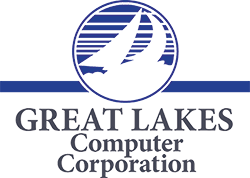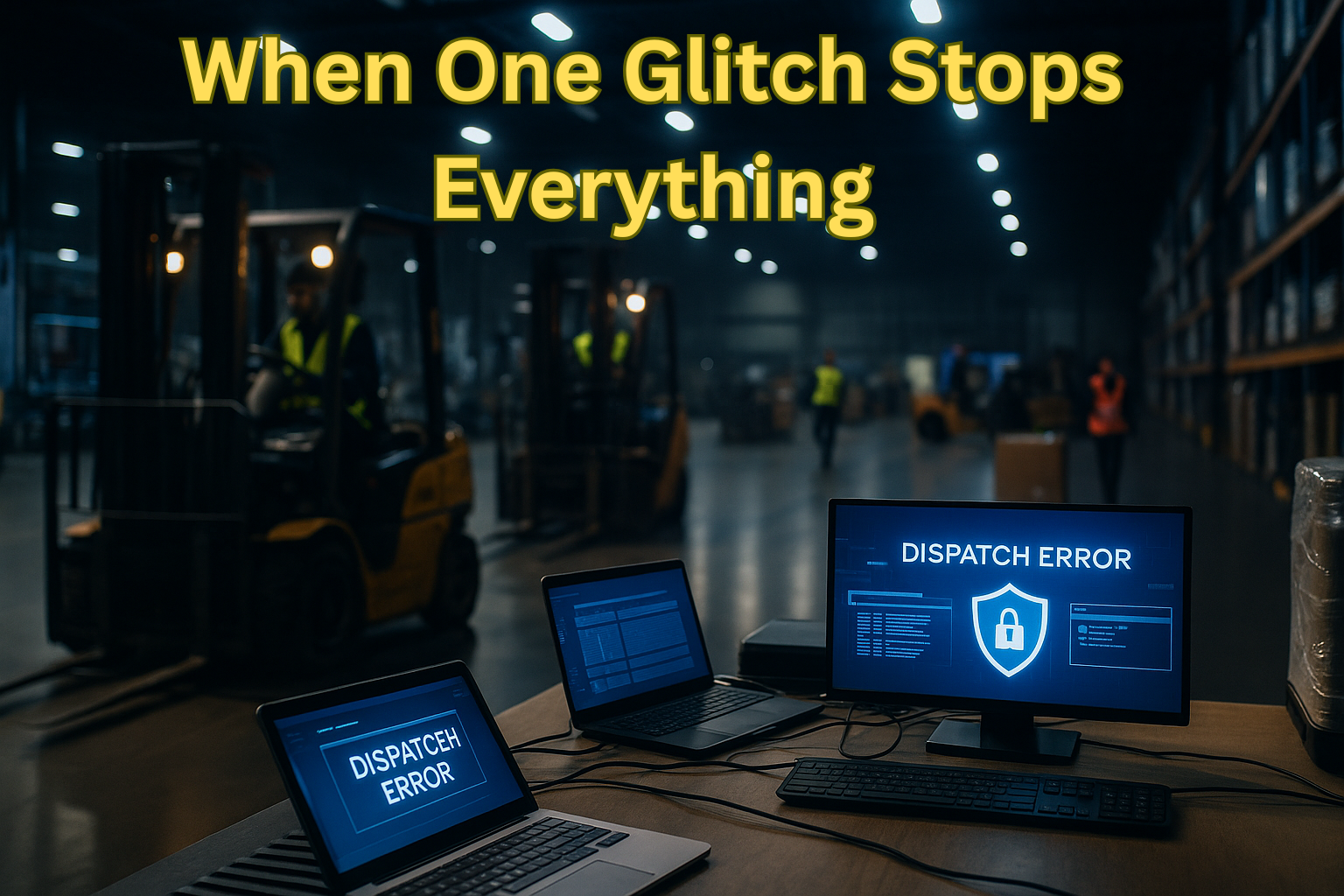When One Glitch Stops Everything
It’s 3:45 a.m. at a regional distribution hub outside Cleveland. Forklifts are running, trucks are lined up, and warehouse crews are hustling through the night shift.
Then, without warning, the order-tracking system freezes.
Dispatch screens go dark. Barcode scanners stop syncing. Drivers idle waiting for paperwork that never prints.
By 4:00 a.m., the dock is silent — not from rest, but paralysis.
That’s what a single IT failure can do in logistics.
Every delay multiplies: one system outage becomes dozens of late trucks, hundreds of missed deliveries, and thousands in lost contracts.
As Great Lakes Computer (GLC) explains in How Logistics & Distribution Firms Can Secure Their Supply Chains from Cyber Threats, modern logistics doesn’t just move freight — it moves data. And when that data stops moving, so does business.
The New Supply Chain Equation: Efficiency + Security
For decades, logistics success meant moving faster and cheaper.
Now it means moving securely.
Digital systems connect fleets, warehouses, and vendors — but those same connections expose vulnerabilities.
Logistics IT today:
- GPS and telematics on every truck.
- Cloud-based TMS (Transportation Management Systems).
- Automated warehouse robotics.
- Vendor portals and real-time tracking.
Each device and API is a potential target.
GLC warns in Why SMBs Can’t Afford to Treat Cybersecurity as an Afterthought that “efficiency without protection is a risk multiplier.”
The True Cost of Downtime
When technology fails, freight doesn’t move.
Every minute matters:
- A warehouse with 50 idle employees can lose $5,000 an hour.
- A carrier with 20 parked trucks can lose $30,000 in revenue daily.
- One corrupted database can disrupt hundreds of routes.
GLC’s Accelerating Business Success: The Importance of a Prompt IT Managed Service Provider Response shows that fast IT responses protect more than uptime — they protect customer loyalty.
Cybercrime on the Open Road
Transportation and logistics have become prime targets for ransomware.
Attackers know one thing: delays cost money, and that means ransom gets paid.
GLC has written extensively on this growing threat in The Ransomware Tide Is Rising.
Common logistics attack vectors:
- Phishing emails disguised as shipment updates (Phishing Emails: Would You Take the Bait?).
- Infected USBs used in warehouse computers.
- Unpatched handheld scanners connected to unsecured Wi-Fi.
- Third-party data leaks from logistics partners.
Consequences:
- Lost cargo tracking data.
- Frozen dispatch and route planning.
- Public trust erosion with customers and carriers.
The Connected Fleet — and Its Hidden Vulnerabilities
Your trucks are no longer just vehicles — they’re rolling data centers.
Each carries GPS, ELDs (Electronic Logging Devices), and telematics units transmitting data in real time. If one system is compromised, attackers can track loads, access driver data, or even disable vehicles remotely.
GLC’s Insider Risk Management and Data Protection reminds us that internal vulnerabilities — from unsecured devices to undertrained staff — can be as dangerous as external hackers.
Fleet security essentials:
- Update all ELD and telematics firmware regularly.
- Require driver authentication for device access.
- Segment fleet management networks from office systems.
- Encrypt all communications between trucks and HQ.
Warehouse Systems: The Digital Engine Room
Your warehouse floor is a symphony of automation — scanners, conveyor sensors, labeling systems, and robots all moving in sync.
When even one device goes offline, operations seize up.
GLC’s Keeping the Wheels Turning: How Manufacturers Can Eliminate Downtime with Better IT Management applies directly here: predictive maintenance prevents costly halts.
How logistics IT parallels manufacturing IT:
- Preventive maintenance = fewer stoppages.
- Centralized monitoring = faster problem detection.
- Standardized hardware = lower repair costs.
Managed IT: From Chaos to Control
Managing dozens of systems — routing, billing, dispatch, fleet, warehouse — overwhelms small IT teams.
That’s why GLC’s 3 Reasons SMBs Need Managed Service Providers argues that MSPs give logistics leaders breathing room to focus on growth, not glitches.
Key benefits for logistics firms:
- 24/7 network monitoring for TMS and WMS platforms.
- Proactive updates for scanners and IoT devices.
- Compliance documentation for DOT and data privacy.
- Predictable monthly IT costs.
With GLC, companies replace fire drills with foresight.
Data Continuity: Backing Up Every Mile
A shipment’s journey is mirrored in its data trail — orders, routes, confirmations. Lose that data, and the load might as well vanish.
GLC’s Disaster Protection: Why Your Business Needs BCDR Now reinforces that backups aren’t optional — they’re insurance against disruption.
Continuity checklist for logistics:
- Daily encrypted backups of dispatch databases.
- Redundant cloud storage for TMS/WMS platforms.
- Offline copies of critical route information.
- Tested recovery drills each quarter.
The Cloud Highway: Driving Collaboration and Speed
Cloud technology now powers everything from order management to customer portals.
In Cloud Computing in 2021, GLC shows how hybrid cloud models help businesses balance control and agility — perfect for logistics firms coordinating multiple hubs.
Cloud advantages:
- Real-time load tracking.
- Secure document sharing between carriers.
- Integration across offices and depots.
- Scalable infrastructure for peak seasons.
Security must-haves:
- Multi-factor authentication for portal logins.
- Encrypted APIs between vendors.
- Regular third-party audits.
Hardware Reliability & Print
Even in a digital age, logistics depends on hardware: label printers, barcode scanners, handhelds, and warehouse PCs.
GLC’s IT Hardware Maintenance and Repair and Managed Print Services keep those devices operational around the clock.
Benefits:
- Fewer shipping delays from broken labelers.
- Automated maintenance alerts.
- Standardized devices across locations.
Hardware downtime is invisible — until the warehouse floor grinds to a halt.
Compliance & Industry Regulations
Transportation and logistics companies juggle multiple layers of regulation:
- DOT for fleet safety
- FMCSA for driver hours and tracking
- PCI DSS for billing security
- State data privacy laws for customer information
GLC’s Beyond Compliance: Why Professional Service Firms Need a Proactive Cybersecurity Strategy applies perfectly here — proactive compliance avoids both fines and downtime.
Compliance checklist:
- Documented data-handling policies.
- Role-based access to systems.
- Automated audit logs.
- Regular penetration testing (What Is It and Why Do You Need It?).
Employee Training: The Human Supply Chain
Drivers, dispatchers, warehouse staff — every employee touches technology daily.
Without proper training, they can unintentionally open the door to attacks.
GLC’s Build a Human Firewall for Your Business shows that the best cybersecurity defense starts with awareness.
Training essentials:
- Spot phishing emails disguised as vendor messages.
- Keep mobile devices updated.
- Avoid connecting to unsecured Wi-Fi on the road.
- Report anomalies immediately.
Cyber awareness saves shipments as much as safety protocols do.
The Path Ahead: AI, Automation & Predictive Security
The next era of logistics runs on intelligence — not just automation, but AI-driven foresight.
GLC’s How AI Can Benefit Your Cybersecurity Strategy explores how machine learning can detect anomalies before humans notice them.
AI opportunities in logistics:
- Predictive maintenance for warehouse machinery.
- Real-time route optimization.
- Automated cybersecurity alert filtering.
- Fraud detection in invoicing and vendor payments.
When data moves smarter, freight moves faster — and safer.
Your Logistics IT Roadmap
- Audit Your Network: Identify legacy systems, outdated firmware, and insecure integrations.
- Secure Your Fleet: Encrypt telematics, authenticate devices, monitor connections.
- Modernize Your Warehouse: Centralize monitoring and automate maintenance.
- Back It All Up: Implement cloud redundancy and test recovery plans.
- Train Your People: Make cybersecurity part of every job role.
- Partner with Experts: Work with MSPs like GLC who know logistics inside and out.
Final Word
In logistics, precision and reliability aren’t optional — they’re survival.
One missed shipment can cost thousands; one breach can cost millions.
Great Lakes Computer helps logistics, distribution, and transportation companies stay ahead — by securing every mile of your digital journey, from warehouse to highway to customer doorstep.
Because in this business, keeping freight moving means keeping your network moving too.

